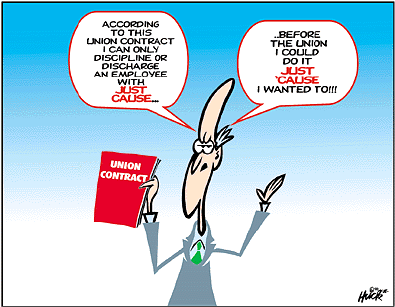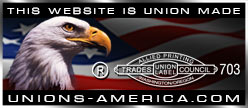Did the Employer Have Just Cause?
Using the Seven Tests
Here are the "Seven Tests" as to whether the boss has used "just cause" in discipline and discharge cases.

Issues
- Our main contractual weapon in discipline and discharge cases is usually the requirement that the boss must have "just cause" (or "fair cause" or "proper cause") to take action against an employee. Even if these words are missing from the contract, many arbitrators use this standard, anyway.
- But, what is "just cause"? Simply put: it means the employer must have a reason (he or she must have "cause") for imposing discipline and the reason must be fair ("just").
- It is commonly accepted that there are seven tests as to whether the boss has used "just cause" in handing out discipline.
One of the main reason workers join unions is to gain protection against unfair and unjust discipline that employers hand out. Stewards must be ready to handle all sorts of discipline cases, from warnings to suspensions to firings. Stewards must be ready to deal with situations of gross discrimination by the boss on who gets disciplined to dealing with union members who sometimes seem to go out of their way to get themselves fired. Important Reminder: Local 70's policies are that your Business Representative write and file written grievances. Contact your Representative and proceed as directed.
Our main contractual weapon is often times summed up in one short sentence, "Employees shall be disciplined or discharged only for just cause". The importance of a sentence like this is that it binds the employer to imposing discipline not just for any reason (cause) but the reason has to be a "just" reason. What is a "just cause" standard ?
It is commonly accepted that there are seven tests as to whether a boss has used "just cause" in handing out discipline. The Bureau of National Affairs lists them as follows:
1. Was the employee adequately warned of the consequences of his conduct?
The warning may be given orally or in printed form. An exception may be made for certain conduct, such as insubordination, coming to work drunk, drinking on the job, or stealing employer property, that is so serious that the employee is expected to know it will be punishable.
Example: If an employee is told to stop using vulgar language and told that if he continues he will be disciplined, that maybe adequate warning. However if a boss comes up to an employee and says "I'm tired of your swearing, cut it out", and then the next day fires the employee for swearing again, that may not be adequate warning.
2. Was the employer's rule or order reasonably related to efficient and safe operations?
Example: A boss makes a rule that all employees must wear red tee shirts and they must be tucked in so they don't get caught in machinery. An employee is fired for wearing a blue tee shirt that was tucked in. Making a rule that tee shirts must be tucked in so they won't get caught in machinery may be reasonable and related to safety, but demanding the tee shirt be blue isn't related to safety or efficiency.
3. Did management investigate before administering the discipline?
The investigation normally should be made before the decision to discipline is made. Where immediate action is required, however, the best course is to suspend the employee pending investigation with the understanding that he will be restored to his job and paid for time lost if he is found not guilty.
Example: The boss fires a worker for stealing and then demands evidence from the union that the worker isn't guilty. At the grievance meeting the boss admits he never investigated the incident, just took another employee's word. This probably wouldn't hold up. If the union has facts to prove the employee's innocence they should be presented to the boss, even though he failed to properly investigate the case.
Tips for Handling Discipline & Discharge Cases
Here are some basic tips for stewards handling discipline and discharge cases:
- Use the "seven tests" as an outline. Did the employer meet the seven tests? Remember that just because an employer messes up on one of the seven tests, this doesn't mean we automatically win, but proving they screwed up helps a lot.
- Make sure that an employee's Weingarten rights aren't or weren't violated during the employer's investigation.
- Try to stop the employer from suspending or firing a worker. Try to get a cooling off period if necessary. The case becomes harder once a worker is out the door, now we not only have to fight about what happened but over back pay, etc.
- Ask for all the employers notes and records they used to make a decision. Get any notes or records a foreman or supervisor might keep, even informal records. The union has a right to them. On the other hand the employer has no right to the notes or records that the union makes when investigating a case.
- Do a thorough investigation of the case. DON'T take the employers word on anything.
- In a grievance meeting make the employer prove their case first. Make them present all the facts and don't assume anything. Don't let the boss start the meeting by saying to the union, " OK tell me why I shouldn't fire Joe". Make the boss justify firing Joe.
- There are two parts to every discipline case. Did the employee violate a known rule and what should the punishment be? Sometimes we lose the first part but then we have to make sure the punishment fits the offense.
- If the employer refuses to back down from a written warning, and the case doesn't merit arbitration make sure the employer receives from the union a written statement disputing the facts and the discipline. Have this letter also put into the employees personnel file.
4. Was the investigation fair and objective?
Example: If an incident happened does the employer interview everyone present or only management people who were present. If the employer refuses to interview nonmanagement workers then the investigation may not be fair.
5. Did the investigation produce substantial evidence or proof of guilt?
It is not required that the evidence be preponderant, conclusive, or "beyond reasonable doubt," except where the alleged misconduct is of such a criminal or reprehensible nature as to stigmatize the employee and seriously impair his chances for future employment.
Example: Here it is obvious that workers have less rights inside the workplace than they would have in civil court, but still the boss must have real evidence, not guesses. Again the boss cannot just try to make a worker prove his or her innocence, without presenting proof of guilt.
6. Were the rules, orders, and penalties applied evenhandedly and without discrimination?
If enforcement has been lax in the past, management cannot suddenly reverse its course and begin to crack down without first warning employees of its intent.
Example: This is the most common form of discrimination. An employer decides to suspend Mary for taking too long at lunch, but lets the employees who eat lunch with a supervisor take extra time every day. This would not hold up. However, if the employer tells everyone that starting on Monday employees will be disciplined for taking too long at lunch and on Tuesday Mary comes back late and everyone else has been on time, she may be disciplined.
7. Was the penalty reasonably related to the seriousness of the offense and the past record?
If employee A's past record is significantly better than that of employee B, the employer properly may give employee A lighter punishment than employee B for the same offense.
Example: The classic example is two employees get in an argument and shove each other. One has 25 years service with a clean record. The other has 3 years service with lots of warnings and discipline. Based upon the workers seniority and records, the employer may give the older worker less punishment than the other worker.
.png)
